According to research by the food and dining industry, we are snacking much more frequently. In the United States, 90 percent of people are snacking multiple times a day and eating less during traditionally scheduled meals, sometimes foregoing them altogether. This is true in my own life. Recently we’ve had fewer proper family dinners and instead, about once or twice a week, we eat smaller, individual snack-like dinners we call “grab and go.”
Interestingly, in a recent interview, the executive chairman of Evernote, Phil Libin, compared trends in technology to snackification (yes, that’s a real term). He explained that the average interaction time when using laptops can be as long as several hours, but interactions with phones are measured in minutes, while interactions with smartwatches last only a few seconds.
So why talk about these food and technology trends toward briefer, more frequent, more casual interactions in a magazine about communication? Because our communication is becoming “snackified” too. At work and at home, there is a definite trend toward shorter, more frequent, more informal interactions while we are doing something else.
Snackification at Work
My own business as a communications consultant is a good example. Slowly, over the years, my clients began requesting shorter and shorter training programs: from multi-day programs to single- or half-day programs to two-hour seminars to hour-long webinars. Now I’m frequently asked to deliver a live Q&A session instead of a formal program and recently, a client requested a series of short one- or two-sentence “tips” in response to specific questions from their team.
We owe it to ourselves to take breaks from technology; we need to disconnect to reconnect.
In fact, snackification of communication is typical in most workplaces. Reports used to be long and detailed. Now many professionals consume and share information either in short, bulleted, slide presentation form or in multiple emails with text and video attachments. Meetings that used to last half a day are getting shorter or are eliminated. Interestingly, according to a 2014 survey, 43 percent of workers avoid spontaneous conversations in favor of email and myriad collaboration tools that enable them to have short “conversations” throughout the day.
Snackification at Home
We also consume entertainment and news in bite-sized chunks. In our house we occasionally listen to podcast episodes or watch a movie together. But sometimes we spend time together while watching short videos, reading or listening to music tracks on tablets or phones individually: I call it being “alone together” on our couch. My personal communication is no exception. I used to have hour-long phone conversations with family and friends, but now I rarely have a telephone conversation lasting longer than a few minutes, and recently even these are being replaced by text messages.
But at age 50-something, I’m a bit late to the party; a survey by OpenMarket from May 2016 reported that 75 percent of millennials actually prefer texting over talking. (The research suggests that this has been a consistently growing trend for several years, indicating that this is not a fad.) I know my kids (twin 12-year-olds) only send texts to their friends (unless I force them to pick up the phone). In fact, my kids have even said, “Mom, if you think about it, phoning is a bit rude—it puts our needs ahead of our friends’.” And that’s consistent with the research data, as well. In addition, millennials prefer texting because they say it’s less stressful since it doesn’t require them to come up with answers on the spot and allows them time to choose and edit their words.
Impact of Snackification
Whenever I mention this trend toward snackification of communication, the immediate response is, “So Lisa, do you see this as a bad thing or as a good thing?” But that’s really the wrong question—because the answer is, It’s both! What’s more important to ask is, “What is the impact of our reliance on digital devices to communicate?” By better understanding both positive and negative consequences, we can make better decisions about our own communication choices.

It’s Fast and Efficient …
On the plus side, it’s easy to argue that brief and transactional communication is efficient. Instead of getting out of the car to spend time getting grilled by your new girlfriend’s father, you simply wait in the car and text, “I’m here.” Texting is the most-used data service in the world; and when you factor in apps such as Messenger and WhatsApp, we send 80 billion messages a day. We send transactional texts to avoid explanations or long conversations. Texts are less intrusive and we can get right to the point. Snackified communication is faster.... And It’s Authentically Compelling
Furthermore, exactly because it is less intrusive, this type of communication needs to be concise and compelling. In today’s world we are all competing for attention. Not only do we have to compete with a barrage of other quick communications, we also compete with other activities. We use our mobile devices to communicate while driving or walking, while at a party, or dinner or work. So if we want to cut through the clutter of a constant stream of communications, our messages need to be clear, concise and compelling.
So how do you gain attention and ensure that your message resonates? You make it informal and appealing, so it’s easy to consume. A communication snack uses short sentences. It uses contractions, emoticons and image stickers to create colorful, casual messages. And it’s exactly this appealing, fun, authentic voice that can be quite compelling.
But Are We Trading Empathy for Efficiency?
Snackified messages, however, are so condensed and informal that they sometimes fail to convey the intended emotional meaning and instead create more misunderstandings. And when we consider the overwhelming amount of electronic exchanges we have, some of which are with people we’ve never met in person or have never even had a phone conversation with, this just increases the chances of misinterpretation.
Written messages don’t carry the tone, pitch or emphasis of our voice, which can make it quite difficult to determine if someone is being e-serious or e-sarcastic, or if a person is just e-busy and not e-angry. In fact, in one study participants were only able to correctly identify the intended emotion of a written message 56 percent of the time (a little better than chance), but when the same message was communicated by voice, correct identification rose to 73 percent. When we don’t hear a voice or see a face, or fully understand the context of written words, we are bound to make incorrect assumptions, which in turn negatively impact how we view others.
Are We Now More Separate and Alone?
Laura, a college student who taught my children digital art over the summer, told me that she didn’t get a phone or her own computer until she was a junior in high school. That was somewhat surprising, but I was even more surprised when she added, “I think having a phone these past few years has made me less understanding, more impatient, and even a bit anxious.” While she recognized the efficiency of snackified communication, she was also painfully aware of emotional misinterpretation. More importantly, she told me that she now found herself comparing her life to others’ lives. In fact, this particular anxiety has been described by psychologists as the “compare-and-despair” factor. We see photos and posts on social media channels from acquaintances and friends at a fancy party and our weekend spent cleaning the house pales in comparison, which then leads to unsettling feelings of personal failure and takes a toll on our self-esteem.How to Have Your Snack and Eat Well, Too
There is no doubt that snackified communication is here to stay, and that it has definite advantages. We are able to stay in touch easily, letting loved ones know they are on our minds. We can get information to people quickly and efficiently. And sometimes it’s just plain fun. But as studies (and Laura’s experience) show, we have to be aware of its drawbacks and make necessary adjustments. One adjustment is to specifically express our emotions, like “I was sad …” or “I am surprised …,” and if necessary before hastily and negatively responding, clarify a confusing message by asking, “Here’s what I got … is that what you meant?”Second, a little face-to-face time without digital devices goes a long way toward reducing emotional misinterpretation and increasing empathy. Sherry Turkle, a Massachusetts Institute of Technology (MIT) researcher who studies how technology influences relationships, wrote a popular book titled Reclaiming Conversation: The Power of Talk in a Digital Age. She says we learn to develop empathy and intimacy through in-person conversations “where we learn to make eye contact, to become aware of another person’s posture and tone, to comfort one another and respectfully challenge one another.” Don’t be put off by “the boring bits” and awkward silences in a conversation, she cautions. “If the conversation goes quiet, you have to let it be. For conversation, like life, has silences. It is often in the moments when we stumble, hesitate and fall silent that we most reveal ourselves to one another,” she writes in a 2015 New York Times editorial titled “Stop Googling. Let’s Talk.”
“It is often in the moments when we stumble, hesitate and fall silent that we most reveal ourselves to one another.”
— SHERRY TURKLEUnfortunately, because of the snackification of communication, and because our technology is almost always with us, we have fewer of these types of meaningful conversations. One thing we can do for ourselves and our children is to schedule “digital holidays” or attend phone-free events. One study showed that sixth-graders who went to camp without their technology for just five days were substantially better at reading human emotions than students who didn’t go to camp or give up their digital devices. In another study just the mere presence of a silent phone reduced how connected a person felt toward their conversation partner. We owe it to ourselves to take breaks from technology; we need to disconnect to reconnect.
Turkle cautions against multitasking in favor of doing one thing at a time. “One start toward reclaiming conversation is to reclaim solitude,” she writes. “Some of the most crucial conversations you will ever have will be with yourself. Slow down sufficiently to make this possible. Think of unitasking as the next big thing. In every domain of life, it will increase performance and decrease stress.”
Find a Healthy Balance
We are all looking for more interaction. But it has to be the right kind. We need to communicate facts clearly and concisely, but we also need to communicate emotion accurately, and develop healthy, supportive, interpersonal relations. This can’t be done through snackified communication alone. Like a healthy diet, our communication must be balanced. And just as we see a new trend in snacks becoming more healthful, I am hopeful that understanding the influence of snackified communication will move us in a healthier direction.
Lisa B Marshall is a communications expert who delivers consulting and workshops, the author of Smart Talk and Ace Your Interview, and host of the Public Speaker and Smart Talk podcasts. Learn more by visiting her website.




 Previous Article
Previous Article